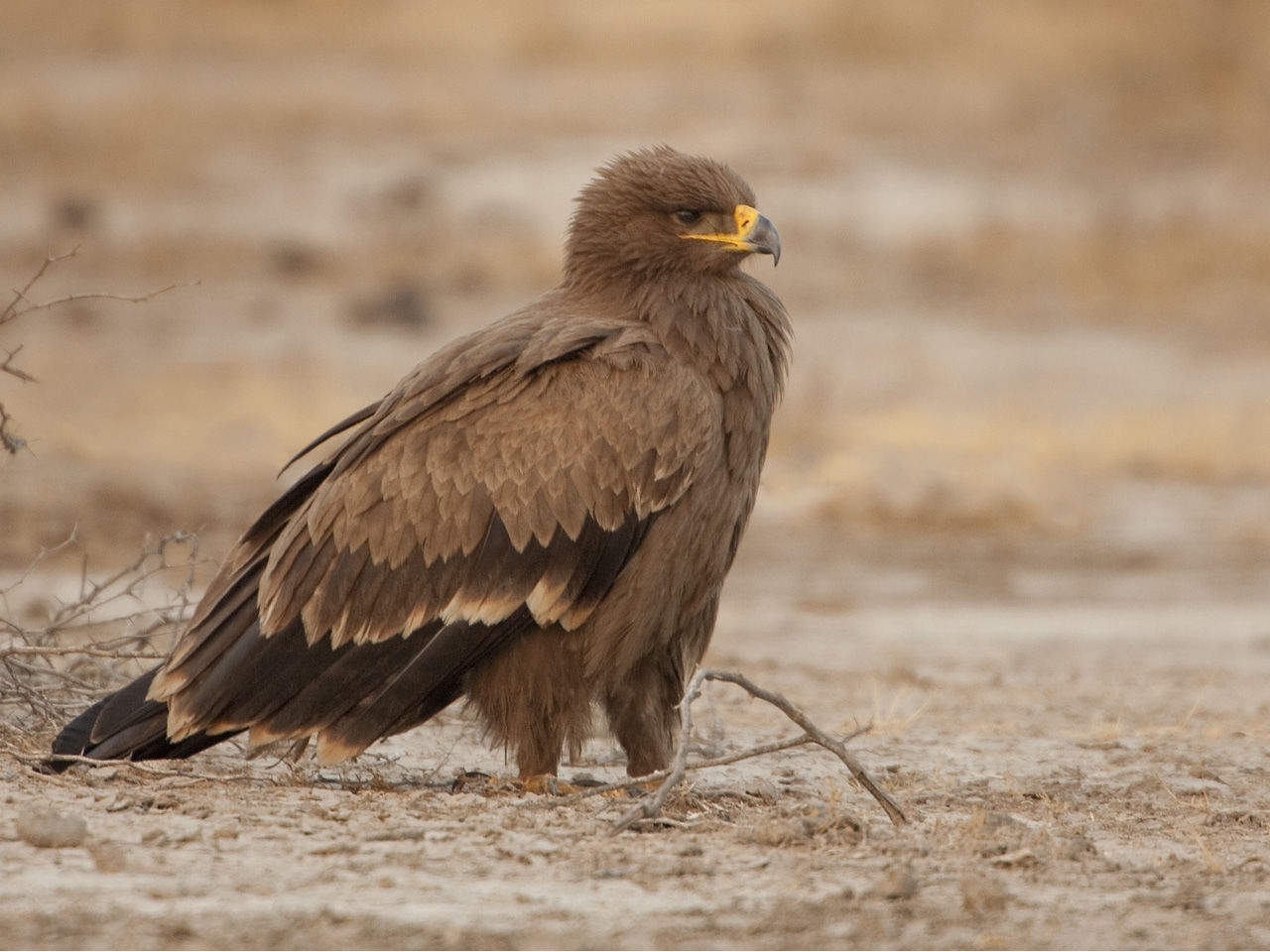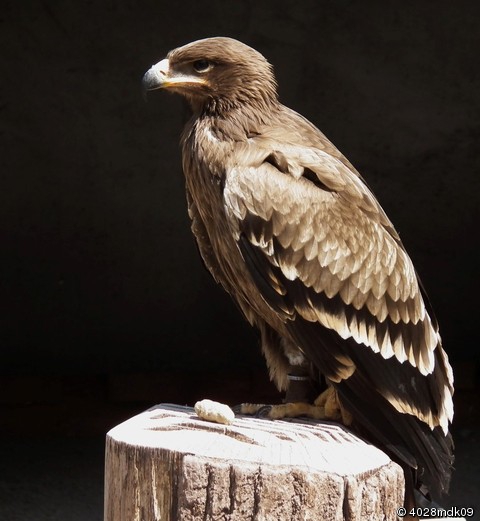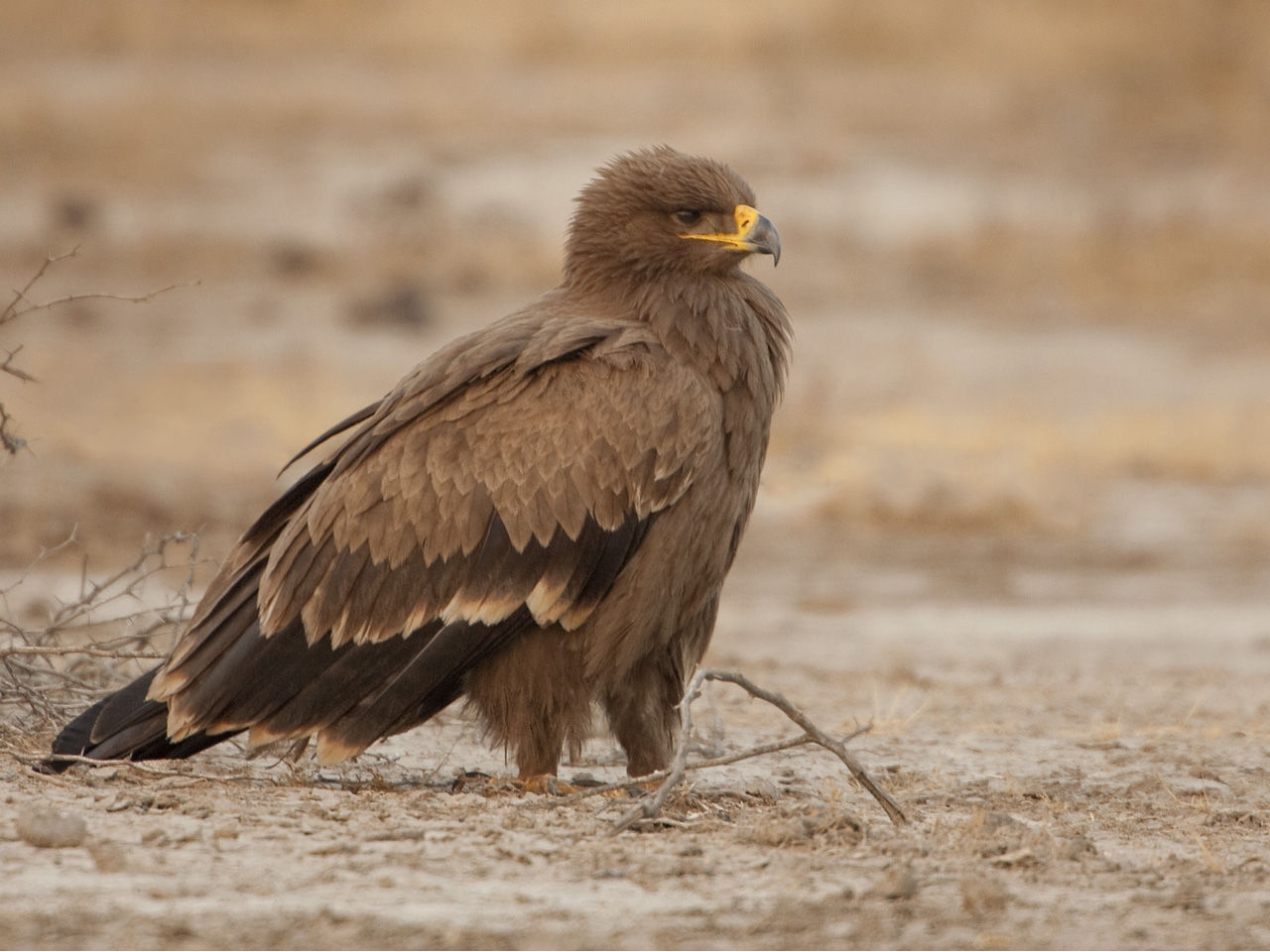| Citation |
|
Description |
Geographic Range [top]
Range Description: This species breeds east of 43°E in European Russia from the Republic of Kalmykia (I. Karyakin in litt. 2016), across Kazakhstan into Kyrgyzstan, China and Mongolia (Meyburg and Boesman 2013). In 2015 it was proven to breed in a small area of Turkey, although the exact range, numbers and trends are still unknown (M. Horvath and I. Karyakin in litt. 2016). It formerly bred in Moldova, Romania and Ukraine. Birds from European Russia, eastern Kazakhstan and Turkey (A. n. orientalis) winter in the Middle East, Arabia and east and southern Africa (Meyburg and Boesman 2013). Birds from Altai, Siberia eastwards (A. n. nipalensis) winter mainly in south and south-east Asia.
The European population is estimated at 800–1,200 breeding pairs or 1,600–2,400 adults. In Russia the population is estimated to be 2,478–3,688 breeding pairs (including 1,176–1,895 breeding pairs in European Russia), in Kazakhstan there are an estimated 22,000–31,000 pairs (I. Karyakin in litt. 2016). The largest numbers are found within the Russian Federation: Republic of Kalmykia – 194 known breeding territories with an estimated 500-700 breeding pairs; Volgograd district – 50 known breeding pairs, estimated 300–500 breeding pairs; Orenburd district – 139 known breeding pairs, estimated 200–350 breeding pairs; Republic of Altai – 301 known breeding pairs, estimated 400–600 breeding pairs; Republic of Tyva – 140 known breeding pairs, estimated 300–400 breeding pairs (I. Karyakin in litt. 2016). The most important breeding populations are: Western Kazakhstan (Usturt Plateau, Emba river basin, Mugodzhary mountains, Or river basin) which forms the transboundary Russian-Kazakh population consisting of approximately 12,000 breeding pairs in an area of c.419,867 km2; Eastern Kazakhstan population estimated at approximately 9,000 breeding pairs (in an area of c.188,080 km2); Western Mongolia (forming the transboundary Russian-Mongolian population, the majority of which are in the Altai-Sayan region in Russia in an area of c.372,283 km2) with an estimated 3,000 breeding pairs; approximately 2,600 breeding pairs in the Volga-Urals (steppe region between the Volga and Ural rivers to the south to the Urda sands) (in an area of c.69,472 km2); approximately 2,000 breeding pairs in Dahuria (transboundary Russian-Mongolian population) in an area of c.153,896 km2) and an estimated 4,000 breeding pairs in Central Mongolia (410,736 km2) (Karyakin et al. 2016). In Mongolia the population may range from 1,500-2,000 up to 6,000-18,000 pairs (Karyakin 2013, I. Karyakin in litt. 2016). The latest estimates indicate that the global population is not more than 37,000 breeding pairs (Karyakin et al. 2016).
Countries occurrence:
Native:
Afghanistan; Albania; Armenia (Armenia); Azerbaijan; Bahrain; Bangladesh; Bhutan; Botswana; Bulgaria; China; Congo, The Democratic Republic of the; Djibouti; Egypt; Eritrea; Ethiopia; Georgia; Greece; India; Iran, Islamic Republic of; Iraq; Israel; Jordan; Kazakhstan; Kenya; Kuwait; Kyrgyzstan; Lebanon; Malawi; Malaysia; Mongolia; Myanmar; Namibia; Nepal; Oman; Pakistan; Palestinian Territory, Occupied; Qatar; Russian Federation; Rwanda; Saudi Arabia; Singapore; South Africa; South Sudan; Sudan; Swaziland; Syrian Arab Republic; Tajikistan; Tanzania, United Republic of; Thailand; Turkey; Turkmenistan; Uganda; United Arab Emirates; Uzbekistan; Viet Nam; Yemen; Zambia; Zimbabwe
Regionally extinct:
Moldova; Romania; Ukraine
Vagrant:
Angola (Angola); Belarus; Burundi; Cameroon; Chad; Croatia; Czech Republic; Denmark; Estonia; Finland; France; Germany; Hungary; Italy; Korea, Democratic Peoples Republic of; Mali; Netherlands; Niger; Nigeria; Norway; Poland; Slovakia; Somalia; Spain; Sweden; Tunisia
Additional data:
? Continuing decline in area of occupancy (AOO): Unknown
? Extreme fluctuations in area of occupancy (AOO): No ? Estimated extent of occurrence (EOO) - km2: 12500000
? Continuing decline in extent of occurrence (EOO): Unknown ? Extreme fluctuations in extent of occurrence (EOO): No
? Continuing decline in number of locations: Unknown
? Extreme fluctuations in the number of locations: No
? Upper elevation limit (metres): 3000
Range Map: Click here to open the map viewer and explore range.
Population [top]
Population: Combined totals from across the whole range estimate the number of pairs at 31,372 (26,014-36,731) which equates to 62,744 (52,028-73,462) mature individuals or 94,116 (78,042-110,193) individuals (I. Karyakin in litt. 2015). The global population is estimated to number less than 37,000 pairs (Karyakin et al. 2016).
Trend Justification: The population is declining owing to habitat destruction (especially conversion of steppe into agricultural land), persecution, and collisions with power lines. Locally populations are declining owing to heavy predation of chicks (Ferguson-Lees and Christie 2001). In Europe the population size is estimated to be decreasing by 80% or more in 49.8 years (three generations) (BirdLife International 2015) however the European population represents only a small proportion of the global population. Combined totals from across the speciess range suggest a decline of 58.6% between 1997-2011 and 2013-2015 (I. Karyakin in litt. 2015).
Current Population Trend: Decreasing
Additional data:
? Number of mature individuals: 50000-75000 ? Continuing decline of mature individuals: Yes
? Extreme fluctuations: No ? Population severely fragmented: No
? Continuing decline in subpopulations: Unknown
? Extreme fluctuations in subpopulations: No ? All individuals in one subpopulation: No
Habitat and Ecology [top]
Habitat and Ecology: It inhabits areas of steppe and semi-desert, and is recorded breeding up to 2,300 m in mountainous regions (del Hoyo et al. 1994). It feeds mainly on small mammals on its breeding grounds, with susliks forming the vast majority of its diet in some areas; when wintering it appears to feed mainly on mole rats in East Africa, and termites and Red-billed Quelea Quelea quelea predominate in southern Africa (del Hoyo et al. 1994). Nests have traditionally been built as large platforms on the ground, although recent habitat alterations seem to have caused a shift to building a few metres higher in bushes or trees (del Hoyo et al. 1994). It also nests on artificial structures. The species is migratory, with birds wintering in south-east Africa and southern Asia (del Hoyo et al. 1994). Migrants leave their breeding grounds between August and October, returning between January and May (Ferguson-Lees and Christie 2001). It avoids sea crossings and thus forms large concentrations at bottleneck sites (del Hoyo et al. 1994, Snow and Perrins 1998, Ferguson-Lees and Christie 2001).
Systems: Terrestrial
Continuing decline in area, extent and/or quality of habitat: Unknown
Generation Length (years): 16.6
Movement patterns: Full Migrant
Congregatory: Congregatory (and dispersive)
Threats [top]
Major Threat(s): The species has declined in the west of its breeding range, including extirpation from Romania, Moldova and Ukraine, as a result of the conversion of steppes to agricultural land combined with direct persecution (Ferguson-Lees and Christie 2001, Meyburg and Boesman 2013). It is also adversely affected by power lines and is very highly vulnerable to the impacts of potential wind energy developments (Strix 2012, Meyburg and Boesman 2013). It was recently found to be the raptor most frequently electrocuted by power lines in a study in western Kazakhstan (Levin and Kurkin 2013). Three sets of factors have been identified as having detrimental impacts on the species in Russia and Kazakhstan: increased mortality owing to collisions with power lines, pesticide poisoning and direct persecution; a reduction in the area of suitable habitat and a reduction in available food; poor breeding success owing to destruction of nests and juvenile mortality during spring fires and disturbance by people and livestock (Strategy of the Steppe Eagle Conservation in the Russian Federation 2016). Young eagles are taken out of the nest in order to sell them to western European countries (Mebs and Schmidt 2006). A decline in the number of birds and a reduction in the proportion of juveniles migrating over Eilat, Israel began immediately after the Chernobyl nuclear accident in 1986, leading Yosef and Fornadari (2004) to suggest that the species may have been affected by radioactive contamination. This species is vulnerable to the veterinary drug diclofenac (Sharma et al. 2014), which was intensively used in the speciess wintering range in Pakistan and India (M. Horvath in litt. 2016).
Conservation Actions [top]
Conservation Actions: Conservation and Research Actions Underway
CMS Appendix II. CITES Appendix II. Bern Convention Appendix II. There are currently no conservation actions known to be in place for this species.
Conservation and Research Actions Proposed
Protect remaining grassland steppes in Europe and the rest of its range. Dangerous electric powerline constructions should be replaced or fitted with protective devices. Educate herdsmen and other locals in the ecological value and vulnerability of this species (Tucker and Heath 1994). Continue research into the impacts of diclofenac and other non-steroidal anti-inflammatory drugs to establish the sensitivity of this species to veterinary drugs. Promote a ban on the use of diclofenac in Europe. Use GPS tracking to confirm migration routes and identify threats during migration (M. Horvath in litt. 2016).
Citation: BirdLife International. 2016. Aquila nipalensis. The IUCN Red List of Threatened Species 2016: e.T22696038A93540565. http://dx.doi.org/10.2305/IUCN.UK.2016-3.RLTS.T22696038A93540565.en. Downloaded on 14 March 2017.
Disclaimer: To make use of this information, please check the .
Feedback: If you see any errors or have any questions or suggestions on what is shown on this page, please provide us with feedback so that we can correct or extend the information provided
|




